Related Research Articles

Alfred Bernhard Nobel was a Swedish chemist, inventor, engineer and businessman. He is known for inventing dynamite as well as having bequeathed his fortune to establish the Nobel Prize. He also made several important contributions to science, holding 355 patents in his lifetime.
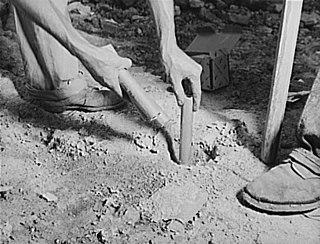
Dynamite is an explosive made of nitroglycerin, sorbents, and stabilizers. It was invented by the Swedish chemist and engineer Alfred Nobel in Geesthacht, Northern Germany, and was patented in 1867. It rapidly gained wide-scale use as a more robust alternative to the traditional black powder explosives. It allows the use of nitroglycerine's favorable explosive properties while greatly reducing its risk of accidental detonation.

An explosive is a reactive substance that contains a great amount of potential energy that can produce an explosion if released suddenly, usually accompanied by the production of light, heat, sound, and pressure. An explosive charge is a measured quantity of explosive material, which may either be composed solely of one ingredient or be a mixture containing at least two substances.

Gunpowder, also commonly known as black powder to distinguish it from modern smokeless powder, is the earliest known chemical explosive. It consists of a mixture of sulfur, charcoal, and potassium nitrate (saltpeter). The sulfur and charcoal act as fuels while the saltpeter is an oxidizer. Gunpowder has been widely used as a propellant in firearms, artillery, rocketry, and pyrotechnics, including use as a blasting agent for explosives in quarrying, mining, building pipelines, tunnels, and roads.

Nitroglycerin (NG), also known as trinitroglycerol (TNG), nitro, glyceryl trinitrate (GTN), or 1,2,3-trinitroxypropane, is a dense, colorless or pale yellow, oily, explosive liquid most commonly produced by nitrating glycerol with white fuming nitric acid under conditions appropriate to the formation of the nitric acid ester. Chemically, the substance is an organic nitrate compound rather than a nitro compound, but the traditional name is retained. Discovered in 1846 by Ascanio Sobrero, nitroglycerin has been used as an active ingredient in the manufacture of explosives, namely dynamite, and as such it is employed in the construction, demolition, and mining industries. It is combined with nitrocellulose to form double-based smokeless powder, used as a propellant in artillery and firearms since the 1880s.

Trinitrotoluene, more commonly known as TNT (and more specifically 2,4,6-trinitrotoluene), and by its preferred IUPAC name 2-methyl-1,3,5-trinitrobenzene, is a chemical compound with the formula C6H2(NO2)3CH3. TNT is occasionally used as a reagent in chemical synthesis, but it is best known as an explosive material with convenient handling properties. The explosive yield of TNT is considered to be the standard comparative convention of bombs and asteroid impacts. In chemistry, TNT is used to generate charge transfer salts.

Cordite is a family of smokeless propellants developed and produced in Britain since 1889 to replace black powder as a military firearm propellant. Like modern gunpowder, cordite is classified as a low explosive because of its slow burning rates and consequently low brisance. These produce a subsonic deflagration wave rather than the supersonic detonation wave produced by brisants, or high explosives. The hot gases produced by burning gunpowder or cordite generate sufficient pressure to propel a bullet or shell to its target, but not so quickly as to routinely destroy the barrel of the gun.
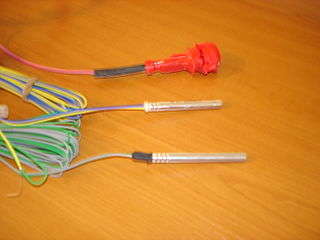
A detonator, sometimes called a blasting cap in the US, is a small sensitive device used to provoke a larger, more powerful but relatively insensitive secondary explosive of an explosive device used in commercial mining, excavation, demolition, etc.

Ammonium nitrate is a chemical compound with the formula NH4NO3. It is a white crystalline salt consisting of ions of ammonium and nitrate. It is highly soluble in water and hygroscopic as a solid, although it does not form hydrates. It is predominantly used in agriculture as a high-nitrogen fertilizer.

ANFO ( AN-foh) (or AN/FO, for ammonium nitrate/fuel oil) is a widely used bulk industrial high explosive. It consists of 94% porous prilled ammonium nitrate (NH4NO3) (AN), which acts as the oxidizing agent and absorbent for the fuel, and 6% number 2 fuel oil (FO). The use of ANFO originated in the 1950s.

Amatol is a highly explosive material made from a mixture of TNT and ammonium nitrate. The British name originates from the words ammonium and toluene. Similar mixtures were known as Schneiderite in France. Amatol was used extensively during World War I and World War II, typically as an explosive in military weapons such as aircraft bombs, shells, depth charges, and naval mines. It was eventually replaced with alternative explosives such as Composition B, Torpex, and Tritonal.

Smokeless powder is a type of propellant used in firearms and artillery that produces less smoke and less fouling when fired compared to black powder. Because of their similar use, both the original black powder formulation and the smokeless propellant which replaced it are commonly described as gunpowder. The combustion products of smokeless powder are mainly gaseous, compared to around 55% solid products for black powder. In addition, smokeless powder does not leave the thick, heavy fouling of hygroscopic material associated with black powder that causes rusting of the barrel.
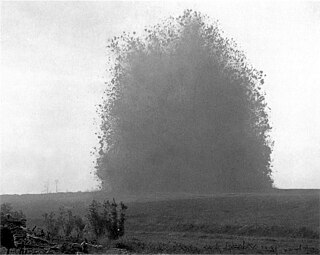
Ammonal is an explosive made up of ammonium nitrate and aluminium powder, not to be confused with T-ammonal which contains trinitrotoluene as well to increase properties such as brisance. The mixture is often referred to as Tannerite, which is a brand of ammonal.
A World War I explosive factory, which was to be later known as NEF Pembrey was built, by Nobel's Explosives, with British Government approval, near the village of Pembrey, Carmarthenshire, Wales. The factory was built on a site consisting of mainly sandhills and sand dunes to provide some protection against damage caused by an explosion. Its main product was TNT (Trinitrotoluene) used for shell filling. The same site was used in World War II to build another explosive factory ROF Pembrey, which also made TNT.
There have been many extremely large explosions, accidental and intentional, caused by modern high explosives, boiling liquid expanding vapour explosions (BLEVEs), older explosives such as gunpowder, volatile petroleum-based fuels such as gasoline, and other chemical reactions. This list contains the largest known examples, sorted by date. An unambiguous ranking in order of severity is not possible; a 1994 study by historian Jay White of 130 large explosions suggested that they need to be ranked by an overall effect of power, quantity, radius, loss of life and property destruction, but concluded that such rankings are difficult to assess.
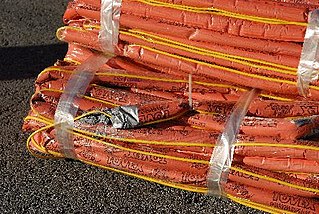
Tovex is a water-gel explosive composed of ammonium nitrate and methylammonium nitrate that has several advantages over traditional dynamite, including lower toxicity and safer manufacture, transport, and storage. It has thus almost entirely replaced dynamite. There are numerous versions ranging from shearing charges to aluminized common blasting agents. Tovex is used by 80% of international oil companies for seismic exploration.
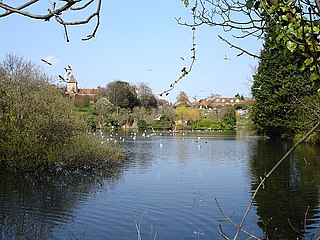
Faversham, in Kent, England, has claims to be the cradle of the UK's explosives industry: it was also to become one of its main centres. The first gunpowder plant in the UK was established in the 16th century, possibly at the instigation of the abbey at Faversham. With their estates and endowments, monasteries were keen to invest in promising technology.

Apache Nitrogen Products began in 1920 as an American manufacturer of black powder based explosives. In the 1930's production transitioned to nitroglycerin-based explosives (dynamite) for the mining industry and other regional users of dynamite. The company changed its name to Apache Nitrogen Products in 1990 to reflect the shift away from Nitroglycerine dynamite to prilled Ammonium Nitrate for the mining industry, and by-products for the fertilizer industry. It occupies a historic location in Cochise County, Arizona and is one of its largest employers.
References
- ↑ Padmanabhan 2019, p. 59.
- ↑ Romane 2020, p. 220.
- ↑ "Roger Bacon | Philosophy, Biography, & Facts | Britannica". www.britannica.com. 2023-05-12. Retrieved 2023-06-27.
- ↑ "The deadly history of ammonium nitrate, the explosive linked to the Beirut blast". Science. 2020-08-06. Archived from the original on March 20, 2021. Retrieved 2023-06-27.
- ↑ Royal Society (Great Britain); Britain), Royal Society (Great; Hutton, Charles; Maty, Paul Henry; Pearson, Richard; Shaw, George; Stuart, Alexander; Britain), Royal Society (Great; Britain), Royal Society (Great (1744). Philosophical transactions of the Royal Society of London. Vol. 43. London: Royal Society of London.
- 1 2 3 "Explosive - Nitramon, Nitramex, and Smokeless Powder | Britannica". www.britannica.com. Retrieved 2023-06-27.
- ↑ Magazine, Smithsonian; Eschner, Kat. "The Man Who Invented Nitroglycerin Was Horrified By Dynamite". Smithsonian Magazine. Retrieved 2023-06-27.
- 1 2 3 "Explosive - Black Powder, Gunpowder, Glazing, and Safety Fuse | Britannica". www.britannica.com. Retrieved 2023-06-27.
- 1 2 Szondy, David (2018-06-15). "New explosive could render toxic TNT obsolete". New Atlas. Retrieved 2023-06-27.
- ↑ "Alfred Nobel's Industrial Activities in Vinterviken". NobelPrize.org. Retrieved 2023-06-27.
- ↑ "Alfred Nobel – Dynamit" (in Swedish). Swedish National Museum of Science and Technology. Archived from the original on 3 October 2017. Retrieved 1 October 2017.
- ↑ "Alfred Nobel Was the Inventor of This Explosive Substance". ThoughtCo. Retrieved 2023-06-27.
- 1 2 "Explosive - Nitroglycerin, Ammonium Nitrate, and TNT Isomers | Britannica". www.britannica.com. Retrieved 2023-06-27.
- ↑ "How to handle gelignite". Wired UK. ISSN 1357-0978 . Retrieved 2023-06-27.
- ↑ "PETN | chemical compound | Britannica". www.britannica.com. Retrieved 2023-06-27.
- ↑ "RDX | explosive | Britannica". www.britannica.com. 2023-06-16. Retrieved 2023-06-27.
- ↑ "Explosive - Detonating Cord, Primacord, TNT, and Shaped Charge | Britannica". www.britannica.com. Retrieved 2023-06-27.
- ↑ "Halifax Explosion". Maritime Museum of the Atlantic. 2013-02-01. Retrieved 2023-06-27.
- ↑ "Texas City explosion of 1947 | industrial disaster, Texas City, Texas, United States [1947] | Britannica". www.britannica.com. 2023-06-06. Retrieved 2023-06-27.
- ↑ "Czech inventions that took the world by storm: the verzatilka, the patentka and Semtex". Czech Presidency of the Council of the European Union. 2022-12-07. Retrieved 2023-06-27.
- ↑ "Beirut explosion: What we know so far". BBC News. 2020-08-05. Retrieved 2023-06-27.